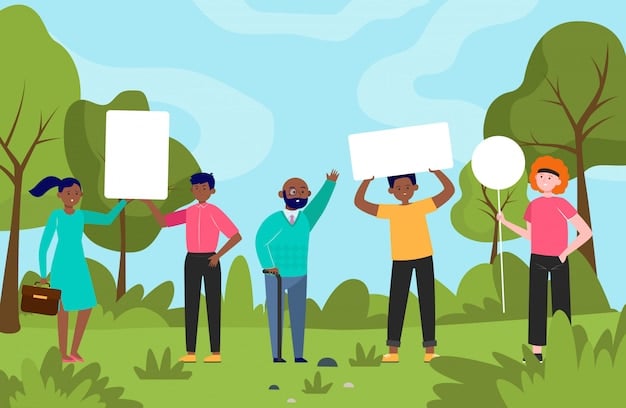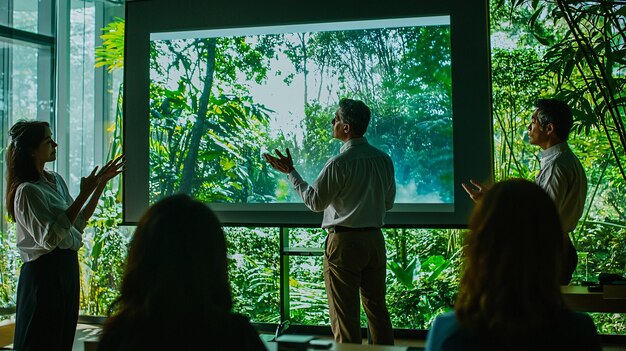Advocate for Environmental Policies in Your Community

Advocating for environmental policies in your community involves active participation, informed engagement, and collaborative action with local stakeholders to drive sustainable change.
Are you passionate about environmental sustainability and eager to make a tangible difference right where you live? Learning how to advocate for environmental policies in your community is a powerful way to translate that passion into impactful, lasting change. While global challenges often dominate headlines, local action is where real solutions frequently take root and flourish.
understanding local governance and policy making
Understanding the intricacies of local governance is the foundational step for anyone looking to advocate for environmental policies effectively. A community’s environmental future is often shaped not just by broad national or international agreements, but by local ordinances, zoning laws, and municipal planning decisions. These are the levers of power closest to you, making them the most accessible for direct influence. Knowing how your local government operates—whether it’s a city council, county commission, or town board—is paramount. Each entity has its own procedures for public input, meeting schedules, and decision-making processes. Identifying key decision-makers, such as council members, city planners, and department heads, is also crucial. These individuals are the gatekeepers and facilitators of policy change, and building relationships with them can significantly amplify your advocacy efforts.
Beyond understanding the structure, it is essential to delve into how policies are actually formulated and adopted at the local level. This typically involves a multi-stage process: idea inception, drafting, public review, committee discussions, and finally, a vote. Each stage presents opportunities for advocates to inject their perspectives and influence the outcome. For instance, before a policy is even drafted, you might engage with local officials to highlight a pressing environmental issue. During the drafting phase, providing expert input or case studies from other successful communities can help shape the policy’s language and scope. Once a draft is public, attending workshops, submitting written comments, and mobilizing community support during public hearings become critical. This procedural knowledge empowers you to intervene at the most opportune moments, ensuring your voice is heard when it matters most.
identifying key decision-makers
Engaging with the right people is critical for effective advocacy. This involves more than just knowing who holds office; it’s about understanding their priorities, their constituencies, and their responsiveness to public input.
- Research local officials’ backgrounds: Look into their professional experiences, past votes, and campaign platforms to understand their leanings.
- Attend public meetings: This provides an invaluable opportunity to observe their interactions and to make your presence known.
- Schedule one-on-one meetings: A direct conversation can be far more impactful than a general email, allowing for deeper discussion and relationship building.
- Identify influential staff: Beyond elected officials, municipal staff often play a significant role in policy implementation and can be powerful allies.
how local policies are adopted
The process of policy adoption is often complex, involving various checks and balances designed to ensure thorough consideration. Understanding this journey helps you pinpoint optimal intervention points. It starts with an identified need or problem, which can come from constituents, staff, or advocacy groups. This leads to the drafting of potential solutions, followed by legal review and financial analysis. Public engagement is a cornerstone, often through public hearings or comment periods, allowing community voices to be integrated. Finally, the proposed policy is presented for a vote, typically by the city council or county board, after which it becomes law if approved.
Connecting with local environmental organizations can be immensely beneficial; they often have established relationships and deep insights into the political landscape. These groups can offer mentorship, resources, and a larger platform for your advocacy. They also tend to have a thorough understanding of the local legislative process, including specific deadlines for public comments or proposal submissions, which are vital for timely intervention. Collaboration helps to pool resources, multiply impact, and ensure that diverse voices are represented in the advocacy process.
building a strong case: research and data
Building a strong case for environmental policies in your community hinges fundamentally on solid research and comprehensive data. Advocacy without evidence can be easily dismissed, whereas well-supported arguments are difficult to ignore and often compel action. This means more than just having a general idea; it requires delving into specific issues, understanding their root causes, and quantifying their impacts. For instance, if you’re advocating for better water quality, you’d need data on local water contaminant levels, their sources, and their effects on public health or ecosystems. Such specificity makes your arguments resonate with decision-makers who need concrete reasons to justify policy changes to their constituents and colleagues.
The research phase should involve identifying credible sources. Look for scientific studies, government reports, university research, and data from reputable non-profit organizations. Local universities, environmental agencies, and even community colleges often have resources or experts who can provide valuable insights and data relevant to your specific locale. Furthermore, don’t shy away from conducting your own localized data collection, if feasible. This could involve simple community surveys, water testing (with proper protocols), or documenting local environmental issues through photographs and detailed observations. Such firsthand data, especially when combined with broader statistics, adds a powerful layer of authenticity and urgency to your advocacy.
compiling compelling evidence
The goal is to translate raw data into a compelling narrative that highlights the urgent need for policy intervention. This involves prioritizing information that directly supports your policy goals and presenting it in an accessible, understandable format for a diverse audience, including non-experts.
- Quantify impacts: Use numbers to show the current environmental damage or the potential benefits of a new policy (e.g., “emissions could drop by 20%”).
- Showcase local relevance: Connect global issues to local effects, making the problem tangible for your community (e.g., “rising sea levels threaten our specific coastal area”).
- Highlight health and economic benefits: Frame environmental policies not just as ecological necessities, but also as improvements for public health and local economies.
- Use visual aids: Graphs, charts, maps, and compelling photographs can make complex data more graspable and impactful.
leveraging expert opinions
Expert validation adds significant weight to your proposals. When a policy is backed by scientists, engineers, public health professionals, or economists, it gains credibility. Reach out to local academics, environmental consultants, or even practitioners in relevant fields who might vouch for your cause. Their endorsement can sway opinion, provide valuable technical insights, and protect your proposals from being easily dismissed as unscientific or impractical. Consider inviting them to speak at public forums or to lend their names to petitions and letters.
Remember, the goal is not just to collect data, but to synthesize it into a clear, concise, and persuasive argument. Present your findings in a way that resonates with both the logical minds of policymakers and the emotional concerns of community members. A well-researched, data-driven approach positions you not just as an advocate, but as an informed problem-solver, making your proposals much more likely to be considered and adopted.
mobilizing community support
Mobilizing community support is perhaps the most vital component in successfully advocating for environmental policies. A single voice, no matter how passionate or well-informed, rarely sways policy alone. It is the collective power of many voices, united by a common cause, that governments and decision-makers truly respond to. Building this collective strength requires strategic communication, persistent outreach, and the cultivation of a broad coalition of stakeholders. The process begins with identifying who in your community would be most affected by, or most interested in, the environmental issue you are championing. This could include residents directly impacted by pollution, local businesses that rely on a healthy environment, schools, faith-based organizations, or even recreational groups.
Effective mobilization means making the issue relevant to diverse segments of the population. Environmental issues can sometimes seem abstract or distant, but they become real when linked to local concerns like children’s health, property values, job creation, or access to natural spaces. Frame your message in terms that resonate with different groups, highlighting how environmental policies can improve their quality of life. For instance, a policy on renewable energy could be promoted for its potential to create local jobs and reduce energy bills, not just for its climate benefits. This broader appeal helps to build a more diverse and robust coalition, increasing the overall influence of your advocacy movement.
grassroots organizing strategies
Grassroots efforts are the bedrock of community mobilization, focusing on direct engagement and empowering individuals to take action.
- Neighborhood meetings: Host informal gatherings in homes, community centers, or local parks to discuss issues and brainstorm solutions.
- Petition drives: Collect signatures both online and offline to demonstrate widespread public support for specific policies.
- Public education campaigns: Organize workshops, distribute flyers, and utilize social media to raise awareness and inform citizens.
- “Phone banking” or door-to-door canvassing: Directly engage residents to discuss the issue and encourage participation.
forming alliances and partnerships
Strategic alliances amplify your voice and expand your reach. This involves identifying and collaborating with other local groups, businesses, and leaders who share similar goals or who stand to benefit from the proposed environmental policies. Consider partnering with health advocacy groups, chambers of commerce, parent-teacher associations, or even local sports clubs. Each partnership brings unique perspectives, resources, and connections, strengthening the overall advocacy effort. For instance, a local business might offer meeting space or printing services, while a health organization could provide data on the health impacts of environmental degradation.

Creating a shared vision and clear calls to action are also essential. People are more likely to participate if they understand exactly what they need to do, how their actions contribute to the larger goal, and what the ultimate positive outcome will be for their community. Regular updates, recognition of volunteer efforts, and celebrations of progress can help maintain momentum and keep community members engaged over the long term. This sustained engagement ensures that your advocacy effort remains a powerful force for change.
effective communication and messaging
Effective communication and tailored messaging are pivotal in influencing public opinion and securing political support for environmental policies. It’s not enough to have a strong case or mobilized community; you need to articulate your position clearly, persuasively, and in a way that resonates with various audiences. This means moving beyond technical jargon and scientific complexity to craft narratives that appeal to shared values, practical concerns, and a sense of collective responsibility. The message should be consistent across all platforms, yet flexible enough to be adapted to specific contexts and target groups. For instance, discussing wetland preservation for a group of fishermen might focus on sustaining fish populations, while for developers, it might emphasize the benefits of flood control and stormwater management.
Tailoring your message also involves understanding the diverse perspectives and potential objections within your community. Address common misconceptions head-on, provide factual corrections, and offer constructive solutions rather than simply pointing out problems. It’s also crucial to highlight the tangible benefits of environmental policies beyond ecological preservation, such as economic growth, public health improvements, or enhanced quality of life. When presenting your arguments, consider using relatable stories or local examples that illustrate the impact of environmental issues and the positive change that policy intervention can bring. This humanizes the issue, making it less abstract and more urgent for everyday citizens.
crafting compelling narratives
Narratives have a unique power to engage emotions and create a personal connection, far more so than raw data alone.
- Focus on local impact: Explain how global environmental trends specifically affect your neighborhood, schools, or local economy.
- Share personal stories: Highlight how individuals or families have been affected by environmental issues, making the problem relatable.
- Present a vision for the future: Paint a clear picture of how the community will benefit from the proposed policies and what success looks like.
- Emphasize solutions, not just problems: Show that there are viable, practical ways to address the environmental challenges.
utilizing diverse communication channels
To reach a broad and diverse audience, you must utilize a variety of communication channels, from traditional media to digital platforms and direct community engagement. Each channel serves a different purpose and reaches different demographics.
- Local media: Write op-eds, letters to the editor, or pitch stories to local newspapers, radio stations, and TV news.
- Social media: Use platforms like Facebook, Instagram, and Twitter to share updates, engaging visuals, and calls to action.
- Community meetings and forums: Organize public discussions, workshops, and town halls to engage directly with residents.
- Creating informational materials: Develop brochures, fact sheets, and websites that provide clear, concise information about the issues and proposed policies.
Consistency and persistence in your communication efforts are key. Environmental advocacy is often a long game, requiring continuous engagement and repeated reinforcement of your message. By strategically crafting and disseminating your narrative through multiple channels, you can gradually shift public opinion, build a stronger base of support, and ultimately create the momentum needed to influence policy decisions.
engaging with local government officials
Direct engagement with local government officials is an indispensable step in transforming environmental advocacy from concept to concrete policy. While community mobilization and strong messaging build public will, it’s the specific interactions with elected and appointed officials that directly influence legislative outcomes. This engagement should be strategic, respectful, and persistent, aiming to build lasting relationships rather than just making one-off demands. Understanding the roles and responsibilities of each official—whether they are a city council member, county commissioner, planning board member, or department head—allows you to tailor your approach and target your efforts effectively. It’s often beneficial to begin by requesting introductory meetings to simply present your group and its core concerns, paving the way for more detailed discussions later.
When you engage with officials, come prepared. This means having your research, data, and proposed policy solutions clearly articulated. Presenting a problem is one thing; offering a well-thought-out, feasible solution is far more impactful. Be ready to discuss the practical implications of your proposals, including potential costs, benefits, and how they align with existing community plans or objectives. It’s also crucial to listen actively to their concerns, constraints, and perspectives. Understanding their challenges, whether political, budgetary, or logistical, allows you to refine your arguments and find common ground. This give-and-take fosters an environment of collaboration rather than confrontation, increasing the likelihood of progressive policy development.
preparing for meetings and presentations
Meticulous preparation is the bedrock of successful interactions with local officials. Your goal is to be perceived as a credible, informed, and constructive partner.
- Define your objective: Clearly state what you hope to achieve (e.g., “secure support for a plastic bag ban”).
- Anticipate questions and objections: Think about potential pushback and prepare concise, data-backed responses.
- Bring relevant materials: Have fact sheets, data summaries, success stories from other communities, and proposed policy language ready.
- Formulate clear “asks”: Don’t just present information; explicitly state what action you want the official to take.
participating in public hearings and workshops
Public hearings and workshops are formal avenues for community input and can be powerful platforms for collective advocacy. They provide an opportunity for your voice, and the voices of your mobilized community members, to be officially recorded and considered.
- Sign up to speak: Even if you only have a few minutes, use the time to deliver a concise, impactful message.
- Encourage widespread participation: Mobilize as many community members as possible to attend and speak, demonstrating broad public interest.
- Submit written comments: Supplement oral testimony with detailed written submissions, which become part of the public record.
- Follow up after the hearing: Send thank-you notes and reiterate your key points in writing to officials.

Remember that advocacy is an ongoing process. Follow up regularly, express gratitude for any progress made, and continue to provide support and information. Building trust and a collaborative relationship with local officials over time will significantly enhance your ability to influence environmental policy and contribute to a more sustainable community.
sustaining long-term advocacy efforts
Sustaining long-term advocacy efforts for environmental policies demands more than just a burst of initial enthusiasm; it requires strategic planning, resilience, and adaptability. Environmental issues are rarely resolved with a single policy victory, and the political landscape often shifts. Therefore, advocates must be prepared for the long haul, maintaining momentum through cycles of legislative action, public engagement, and potential setbacks. This involves continually monitoring policy implementation, identifying new challenges or opportunities, and adapting strategies to remain effective. It also means nurturing the community base that you’ve built, keeping them informed, engaged, and empowered even when the immediate spotlight is off. Regular communication and celebrating small victories can prevent burnout and maintain a sense of progress.
Moreover, embedding environmental sustainability into the community’s fabric requires a commitment to ongoing education and capacity building. This helps to cultivate a new generation of advocates and ensures that the movement outlives its original leaders. Workshops, school programs, and public awareness campaigns can foster a deeper understanding and appreciation for ecological principles, making future policy changes easier to implement. By building a local culture of environmental stewardship, you create fertile ground for policies to not only be passed but also to be successfully enforced and embraced by the community. This long-term vision transforms advocacy from a series of campaigns into an enduring commitment to local environmental health.
monitoring policy implementation and impact
Passing a policy is only half the battle; ensuring its effective implementation and monitoring its real-world impact is equally critical. This involves vigilance and ongoing data collection.
- Track compliance: Monitor whether the new regulations are being followed by businesses, residents, and government entities.
- Assess environmental outcomes: Collect data to see if the policy is actually achieving its intended ecological benefits (e.g., improved air quality, reduced waste).
- Identify gaps or unintended consequences: Be open to refining or amending policies if they are not working as intended or if new issues arise.
- Report findings: Share your assessments with the public and local officials, holding decision-makers accountable and advocating for necessary adjustments.
adapting to new challenges and opportunities
The environmental landscape is dynamic, with new challenges emerging and new solutions becoming available. Effective long-term advocacy requires flexibility and a willingness to evolve.
- Stay informed about scientific advancements: Integrate new research and technologies into your advocacy proposals.
- Track legislative changes: Be aware of state and federal policies that might affect local environmental efforts.
- Respond to changes in public opinion: Adjust your messaging and strategies to maintain relevance and support.
- Seize new opportunities: Be ready to advocate for policies that arise from new grants, funding programs, or emerging political will.
Ultimately, sustained advocacy means becoming a consistent, trusted voice within your community for environmental protection. It’s about demonstrating that environmental policies are not isolated issues but are integral to the well-being, prosperity, and future of the entire community. This steadfast commitment to environmental health ensures that your efforts leave a lasting legacy of positive change.
celebrating successes and learning from setbacks
Celebrating successes, no matter how small, is a critical element in sustaining motivation and demonstrating the tangible impact of advocacy efforts. Acknowledging milestones—whether it’s the passage of a local ordinance, a successful community clean-up, or even just increased public awareness—provides a much-needed morale boost for advocates and reinforces the value of their hard work. These celebrations can be formal, like a press conference announcing a new policy, or informal, such as a community potluck to thank volunteers. Publicly recognizing the contributions of individuals and groups involved helps to retain volunteers, attract new supporters, and showcase the power of collective action. It also serves to illustrate to the broader community that advocacy works and that their engagement can indeed lead to positive change.
Equally important, yet often more challenging, is the process of learning from setbacks. Environmental advocacy is rarely a straightforward path; obstacles, delays, and outright defeats are almost inevitable. When a policy proposal fails, or a campaign loses momentum, it’s crucial to resist discouragement and instead debrief thoroughly. Analyze what went wrong: Was the messaging unclear? Was there insufficient data? Were key stakeholders not engaged effectively? By objectively reviewing failures, advocates can identify weaknesses in their strategy, refine their approach, and build a more robust plan for future endeavors. This reflective practice transforms setbacks into valuable learning opportunities, fostering resilience and strategic growth.
acknowledging achievements
Actively recognizing and publicizing successes helps to maintain enthusiasm and demonstrate the real-world impact of advocacy.
- Host appreciation events: Organize gatherings to thank volunteers, donors, and supportive community members.
- Share success stories: Use your communication channels to highlight how policies or campaigns have made a positive difference.
- Publicly thank officials and partners: Acknowledge the contribution of local government and allied organizations.
- Document progress: Keep a record of policy victories and measurable environmental improvements.
lessons from challenges
Every challenge presents an opportunity for growth and refinement of your advocacy strategy. A constructive approach to setbacks is crucial for long-term effectiveness.
- Conduct post-mortem analyses: Gather key team members to discuss what happened, why, and what could be done differently.
- Seek external feedback: Talk to community members, unsupportive officials, or external experts to gain different perspectives on the challenge.
- Refine strategies: Adjust your messaging, target audience, or tactics based on lessons learned.
- Maintain resilience: Understand that advocacy is a long game and setbacks are part of the journey; learn, adapt, and move forward.
By consistently celebrating successes and constructively learning from setbacks, environmental advocates can build a resilient, adaptive, and ever-improving movement within their community. This continuous cycle of action, reflection, and adaptation is key to achieving lasting environmental policy change and ensuring a sustainable future.
| Key Point | Brief Description |
|---|---|
| 📚 Research & Data | Ground your advocacy in credible data and expert opinions to build a compelling case. |
| 🤝 Community Mobilization | Unite residents and form alliances for a stronger, more influential collective voice. |
| 🗣️ Effective Communication | Tailor your message to appeal to diverse audiences and use various channels. |
| ⚙️ Engage Officials | Directly interact with local government to present solutions and build relationships. |
frequently asked questions
The crucial first step is to thoroughly understand your local government’s structure and decision-making processes. Identify key officials and how policies are initiated, drafted, and adopted in your specific community. This foundational knowledge empowers you to engage effectively and target your advocacy efforts where they will have the most impact.
To make your advocacy more persuasive, ground your arguments in solid, credible research and data. Use local examples and personal stories to highlight the direct impacts. Additionally, leverage expert opinions and frame environmental policies in terms of tangible community benefits like health improvements, economic growth, or quality of life enhancements, rather than just ecological necessity.
Yes, community support is absolutely vital. A collective voice carries far more weight than individual efforts. Mobilizing broad community support through grassroots organizing, public education, and strategic alliances demonstrates widespread public demand for policy change. Decision-makers are much more likely to act when they see a united front of concerned citizens.
The best way to interact with local officials is to be strategic, prepared, and respectful. Request meetings, come with clear objectives and well-researched solutions, and listen to their perspectives. Participate actively in public hearings and follow up on discussions. Building a relationship of trust and collaboration increases your influence over time.
To ensure long-term impact, sustain your advocacy efforts by monitoring policy implementation, adapting to new challenges, and continually educating your community. Celebrate successes to maintain morale and learn constructively from setbacks. Building a resilient, informed movement over time helps embed environmental stewardship deep within your community’s values.
conclusion
Effectively advocating for environmental policies within your community requires a multifaceted, strategic approach that integrates deep understanding of local governance with robust research, collaborative community engagement, and persuasive communication. By consistently applying these principles, you can transform passion for sustainability into tangible, lasting change. The journey is often marathon, not a sprint, demanding patience and persistence, but the rewards of a healthier, more sustainable community are immeasurable. Your active participation is not just a hope; it is the vital catalyst for local environmental progress.





